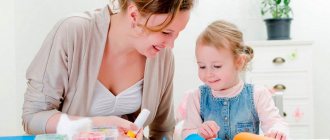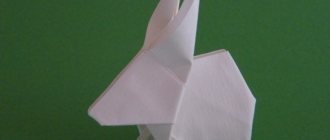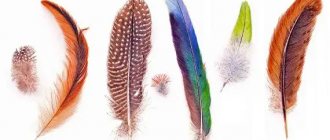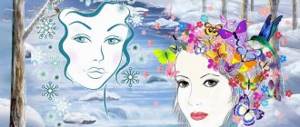Preparing tools
Before you start an exciting drawing, you need to prepare everything you need. The first thing parents need to take into account is that such equipment is quite dirty for everything around it. Splashes from the brush fly in all directions and can easily ruin both the table surface and the child’s clothes. Therefore, take care in advance of a protective apron and a special oilcloth for creativity. The rest of the set is quite simple:
- gouache paints (watercolor is also possible);
- medium hard toothbrush;
- brush;
- jar lid.
Having prepared everything you need, start creating!
Frosty drawings on windows for the New Year with paints: examples of ready-made patterns
It is unlikely that anyone will object to you if you say that no one can make patterns on windows better than frost itself. And yet, most of us, preparing for the winter holidays, make frosty drawings on the windows for the New Year with paints. It is enough to look at examples of ready-made patterns to understand how beautiful it is. Would you like to try decorating your home in the same way?
How to draw a frosty pattern on a window - Master class with step-by-step steps
In order to draw unusual frosty patterns on the windows for the New Year with paints (you will find examples of ready-made patterns below), you first need to prepare everything you need. Prepare paint (you can take toothpaste), brush, sponge and start creating a small masterpiece.
- Dilute toothpaste or white gouache to the consistency of liquid sour cream. Dip a sponge into the solution, remove excess liquid from it and begin to cover the windows with “frost” by pressing the sponge to the glass and sharply removing it from the window.
- After the base of the design has dried, cover its surface with patterns drawn with a brush.
- Wait again until the almost finished drawing dries, and again blot it with a sponge dipped in white paint or toothpaste.
- You can scratch a clear pattern on the paint that has not yet dried (do this with the back of the brush).
- On the top of the windows, you can depict a starburst by applying snowflake patterns to the glass and filling the space around them with paint applied with a dishwashing sponge.
- Doesn't the drawing resemble the frost's New Year's efforts?
How to draw with a brush?
The technique of drawing with a toothbrush itself is quite simple. First, take the lid and apply some paint to it, then thin it with water. Do not add too much water so that the shade does not lose its brightness. Place a blank sheet of paper in front of the child and, dipping the brush into the lid, offer to draw something. Typically this technique uses mock-ups. To do this, an adult draws a tree trunk, an outline of a house, a sketch of an animal, etc. on a sheet of paper in advance. And the child adds strokes using a brush with paint. You can offer your baby a Christmas tree, because the New Year holidays are approaching.
To do this, draw the trunk of the spruce and dilute the green paint in the lid. Using a brush, the Christmas tree needles can be depicted quite realistic, and the drawing itself turns out to be interesting and unusual. Decorate the finished spruce with balls drawn with a regular brush.
A child draws... with his fingers, a carrot, a pipette and a toothbrush
Drawing for a child is a necessary and useful activity. It introduces him to the world of beauty, develops creativity, fantasy, imagination, and forms aesthetic taste. Among other things, drawing for a child is a good way to practice motor skills, develop senses, and relieve stress. If you are a little bored with the album and pencils, or if the baby is very small, you can find a worthy alternative. To do this, it is enough to introduce an element of novelty into the usual activity.
A child draws: fingers like a fan
It is not always easy for the youngest artists to handle a brush or pencil. But they have drawing tools that they “always have with them.” These are fingers and palms. By drawing with them, the baby creates his first artistic images, enriches his tactile experience with new sensations, experiments and simply rejoices.
Finger paints are a wonderful invention. They are easy to use and harmless to children. It is better to paint with such paints on large sheets of paper. You can place the sheets directly on the floor (pre-cover the floor with oilcloth or newspapers). Pour some paint onto the paper and let your child smear it with his fingers and palms. Add another color so you can mix the colors together. Invite your child to try cotton swabs, a parrot feather, an old toothbrush, etc. as drawing tools. In each case the results will be different, and it is interesting to compare them.
Here's another fun thing to do with your fingers. Take a round piece of foam sponge, dilute a little gouache with water and saturate the sponge with paint. Now press your baby's thumb against the sponge and let it leave an imprint on the paper. Then again and again... “Print” the caterpillar by arranging the sponge prints in a chain. This way you can draw leaves on a tree and flowers in a meadow.
Just typing with your fingers is definitely fun. But it’s even more fun when the prints turn into funny animals, vegetables, fruits and generally anything else you want. Draw the eyes, nose and hair - you get a funny face, add a snout - you get a pig. First, the baby prints with his fingers, and his mother paints his prints. And a little later the baby will want to try it himself. To make drawing even more interesting, accompany these activities with a poem:
Does mom scold you for dirty hands? Dirty hands help in science! Let's smear our fingers with paint, and lo and behold, the stains have gathered in a big round dance.
Do you think it's just a stain? It might turn into an elephant Or into a peacock with a luxurious tail... Just wash your hands afterwards! (Yu. Kasparova)
Drawing lessons for children: carrots, beets and oranges are used
Paints and pencils are, of course, interesting. But a real artist will not limit himself only to familiar materials. It is worth showing your child that you can draw not only with paints. This way the child will get a new wonderful experience.
So, let's think about what you can use to draw with? For example, all kinds of vegetables, fruits and berries. Diced raw and boiled beets and carrots, tomatoes, lemons, oranges, cranberries, strawberries, cherries, apricots, currants, rowan and viburnum berries, etc. are suitable. Show your little one how to take pieces of fruit and vegetables and move them across the paper, leaving lines, zigzags and streaks. Try to paint a whole picture using different colors.
It’s also great to draw on paper with a piece of ordinary coal.
Drawing for children: decorating plates and saucers
If your child is bored with drawing in a regular album, invite him to paint a paper plate and cup with patterns. This can be done with a brush, fingers, paints, and felt-tip pens. Show how to dot, draw lines and zigzags to create a pattern. Let the child draw flowers or berries. You'll see, it will turn out cute!
Teach your baby to trace his palm and various objects: saucers, cups, molds for cookies and sand, construction parts, etc. To do this, the child must press the object onto a sheet of paper with his left hand so that it does not move, and with his right hand, carefully trace it. At first, help your child. You will get silhouettes that you can then paint or decorate with patterns. Let the baby trace his own palm on the paper first, and then his mother’s (and his father’s too). Invite the little one to finish drawing his nails, let him “put” rings on his fingers, and bracelets and watches on his wrists. The kids really love this funny drawing. Or you can paint each finger so that it looks like a cheerful little man. Like in this poem:
There are exactly five of us on hand! We can draw, We can hold a spoon at dinner, We can grab a cat by the whiskers, We can pull on our socks, We can tie our own shoelaces, We can wash our shoes, We can make boats out of paper, We can touch daddy’s bristles that grow on his chin. And we live very friendly, the kids don’t get bored with us! (Yu. Kasparova)
"Smart" drawing for children: with ice and a pipette
Shouldn't we try to deviate a little from the usual drawing and offer the child unusual activities? This is both a creative experience and the first scientific experiments.
You can draw with several markers at the same time. The kid will certainly appreciate such a “trick.” Take 3-4 felt-tip pens or markers and tie them together with tape. Make sure they are the same length and can write at the same time. Now the baby will be able to make just one movement and receive several colored lines at once. If you draw rain or grass, you will get a lot of colored strokes. If you draw an arc, it will look like a rainbow.
Surely your little one will enjoy the experiment of freezing colored pieces of ice. Pour some water into cups and color it with different colors of food coloring. Pour colored water into ice cube trays, filling them a quarter full. Place the molds in the freezer with your child and freeze. Then take out the colored ice cubes. Let the baby look at them, touch them and make sure that liquid water has turned into solid ice. Now take a large sheet of paper, place it on the table, and let the baby place colorful pieces of ice on top. And then we will watch how the ice in a warm room melts and turns back into water. But our water is unusual! The ice floes will turn into multi-colored puddles, the paint will begin to mix, forming colored stains on the paper. Draw your child's attention to the fact that mixing colors creates new colors. Let the paper dry and then look at it with your baby. Imagine what it would be like. What if the baby wants to finish drawing something? You can place a toothpick in each ice cube while freezing. Then the child will be able to move the colored cubes across the paper, watching as the ice melts and leaves behind colored traces.
A useful and interesting activity is drawing with a pipette. Dilute some paint of different colors in cups and show your child how to put colored water into a pipette and drip it onto paper. Little artists will be interested in the process itself. They will watch how the droplets fall, spread, mix with each other, forming multi-colored stains. And let older children try to depict something recognizable with the help of colored drops. Dry the drawings. And be sure to save the most successful ones. They are suitable as a background for applications. You can also color the pictures... with plasticine. To do this, it is better to take a coloring book with large drawings and a thick outline. Show your child how to smear plasticine over the drawing, filling in the contours. Great workout for fine motor skills!
All sorts of things
To prevent the sheet of paper on which your child is drawing from moving around the table and to prevent the paint from staining it, place the paper in the lid of a cardboard box (for example, a shoe box or a pizza box). Cardboard edges will help the paint not go beyond the edge of the sheet. You can even put such an improvised easel on your lap and paint like that.
You can make a wonderful album for children's drawings. Each page will be made of different paper. Drawing their first “scribbles” with pencils, pens and felt-tip pens, kids will move them over materials with different textures and get a new result each time. And this is simultaneously creativity, the development of imagination, and the first experimentation.
How to make such an album? Let's take paper of different textures: packaging, wrapping, colored, velvet, waxed, corrugated, newspaper, parchment, wallpaper with different textures, etc. You can add foil, thick fabric, cellophane, plastic bags, etc. From all this variety, cut out pages of the same size (25x40 or 25x25 cm). Fold the paper into a bundle and staple it on one side or sew it with thread to make an album. You can make a white cover on which the baby will leave colored fingerprints and palm prints. The album is ready, you can start creating. It will be interesting for the child to observe how different papers “react” differently to pencils and markers. He will also enjoy trying the paper by touch, because the sheets are so different from each other. Surely the album will become your inquisitive artist’s favorite toy for a long time. Happy drawing lessons!
Teacher's advice
Don’t forget to often arrange exhibitions of your child’s most successful works. Let dad, grandparents, and guests admire his work. Select drawings for the exhibition together, taking into account the wishes of the little artist. In this simple way, you will show your child the value of his creativity, help him become more confident and support his desire to create new wonderful drawings.
Psychologist's advice
Give your child creative freedom. It is absolutely not necessary to demand that the color of the picture correspond to reality. If your little one wanted to paint the sun pink and make the grass blue, let him paint it. This means that this kind of self-expression is important for him right now. This will allow him to relax internally and believe in himself, in his vision of the world.
Spray
Another unusual technique is splatter painting with a toothbrush. However, for this you need to prepare stencils or large tree leaves, ideally maple leaves. Take a white piece of paper and place the stencil on it. Now dip the brush into the lid and run the brush over the bristles to create a lot of spray.
It is best to use a brush not for paints, but for glue, since it is more suitable in terms of hardness. Alternate different shades of paint to create a multi-colored spray. When the white sheet is covered with paint, remove the stencil. The area underneath should remain perfectly white. In this way you can draw not only leaves, but also animals, fruits and vegetables, etc. The main thing is to cut out a suitable outline from paper.
What to paint on glass with stained glass paints for the New Year 2020: Video and photo examples
If you plan to clean the windows from drawings immediately after the end of the New Year holidays, use easily washable paints for glass work that do not leave marks or streaks - watercolors, toothpaste, gouache. As a last resort, use acrylic paints - they can also be washed off. Well, what is it possible to paint on glass with stained glass, almost indelible paints for the New Year 2020? Watch our video and photo examples of work.
Examples of works for the New Year using stained glass paints
For the winter holidays, you can prepare unique gifts for your family and friends - using the glass painting technique, create with your own hands originally decorated wine glasses, framed pictures, even simple jars painted with unusual patterns. If you have not yet chosen what to paint on glass with stained glass paints for the New Year 2020, the video and photo examples posted on this page will give you ideas.
Combining two techniques
The most beautiful and unusual drawings are obtained by combining two techniques together. To do this, first use a spray that will serve as a background. And then drawing with a brush.
Since it may be difficult for a young child to draw complex scenes, offer him very basic pictures. Invite your child to draw a cat on paper. Using a simple pencil, draw an oval body, paws, tail and head. Then give your child a brush with gray paint and ask him to make fur for the cat. Due to the stiff bristles, the animal's fur will turn out exactly as needed. After the cat is ready, draw small details: muzzle, ears and whiskers.
With the use of drawing with a toothbrush in kindergarten, the fine motor skills of young children are developed, as well as the development of imagination. In addition, such an original way of creativity perfectly calms the nervous system, activates brain activity and generally has a positive effect on the child’s emotional background. Drawing with a toothbrush is suitable for school-age children and even adults. Plunge into creativity and give free rein to your imagination!
What can you draw on the window for New Year 2020 at school: photo and video examples
New Year is celebrated in every home and, of course, in all institutions. By the time January arrives, the walls of the premises are decorated with “winter” decor - garlands, tinsel, balloons and glass balls. What can you draw on the window for New Year 2020 at school? Photos and video examples of finished work completed by teachers and schoolchildren will answer this question.
Examples of New Year's drawings on school windows
What and with what can you draw on the window for the coming New Year 2018 at school so that the drawing can be washed off later? In the photo and video examples you can see that the images are applied with fairly intense, thick strokes. Will such beauty be washed off after the winter holidays? Of course, unless you use oil paints. Gouache, watercolor, toothpaste are washed off with hot water and detergent.






